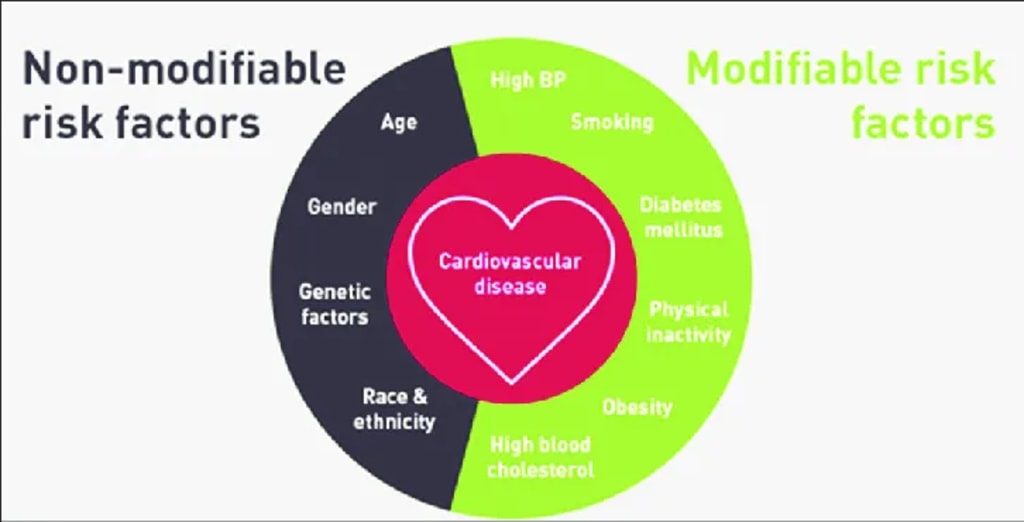Cardiovascular Risk Factors
What are the risks of heart disease?

Cardiovascular diseases (CVDs) remain the leading cause of mortality worldwide, with several modifiable risk factors contributing to their development and progression. Understanding these risk factors is essential for preventing CVDs and promoting heart health.
1. Hypertension (High Blood Pressure): Elevated blood pressure puts increased strain on the heart and blood vessels, leading to arterial damage, atherosclerosis, and an increased risk of heart attack, stroke, and heart failure. Lifestyle modifications (e.g., healthy diet, regular exercise, stress management) and antihypertensive medications are key to managing hypertension.
2. Dyslipidemia (High Cholesterol): Abnormal levels of cholesterol, particularly elevated levels of low-density lipoprotein (LDL) cholesterol and triglycerides, and reduced levels of high-density lipoprotein (HDL) cholesterol, contribute to the development of atherosclerosis. Dietary changes, exercise, statin therapy, and other lipid-lowering medications help control dyslipidemia and reduce cardiovascular risk.
3. Diabetes Mellitus: Both type 1 and type 2 diabetes increase the risk of CVDs. Chronically elevated blood glucose levels damage blood vessels and promote inflammation and oxidative stress. Tight glycemic control, along with lifestyle modifications and medications, is essential for reducing cardiovascular risk in individuals with diabetes.
4. Smoking: Tobacco smoke contains numerous harmful chemicals that damage the cardiovascular system, including nicotine, carbon monoxide, and tar. Smoking accelerates atherosclerosis, increases blood pressure and heart rate, promotes thrombosis, and reduces oxygen delivery to tissues. Smoking cessation is the single most effective intervention to reduce cardiovascular risk.
5. Obesity and Sedentary Lifestyle: Excess body weight, particularly abdominal obesity, increases the risk of CVDs by promoting insulin resistance, dyslipidemia, hypertension, and inflammation. Physical inactivity further exacerbates these risk factors. Adopting a healthy diet, engaging in regular physical activity, and achieving and maintaining a healthy weight are essential for cardiovascular health.
6. Unhealthy Diet: Diets high in saturated and trans fats, cholesterol, sodium, and refined carbohydrates contribute to dyslipidemia, hypertension, insulin resistance, and inflammation. Conversely, diets rich in fruits, vegetables, whole grains, lean proteins, and healthy fats (e.g., monounsaturated and polyunsaturated fats) support cardiovascular health. The Mediterranean diet, in particular, has been associated with a reduced risk of CVDs.
7. Excessive Alcohol Consumption: While moderate alcohol consumption may have cardiovascular benefits, excessive drinking is associated with an increased risk of hypertension, cardiomyopathy, arrhythmias, and stroke. Individuals should adhere to recommended limits for alcohol intake (e.g., up to one drink per day for women and up to two drinks per day for men) to minimize cardiovascular risk.
8. Stress and Mental Health: Chronic stress, depression, anxiety, and social isolation can negatively impact cardiovascular health through mechanisms such as sympathetic nervous system activation, inflammation, and unhealthy coping behaviors (e.g., smoking, overeating). Stress management techniques, social support, and mental health interventions are essential components of comprehensive cardiovascular risk reduction strategies.
9. Family History and Genetics: A family history of premature CVDs (i.e., occurring in close relatives before age 55 in men or age 65 in women) and certain genetic factors influence an individual’s susceptibility to CVDs. While these factors cannot be modified, they highlight the importance of early screening, close monitoring, and proactive management of modifiable risk factors in high-risk individuals.
10. Age and Gender: Advancing age is a significant risk factor for CVDs, with the prevalence increasing markedly after age 65. Men typically have a higher risk of CVDs than premenopausal women, although the risk in women increases postmenopause. Age- and gender-specific screening and management strategies should be tailored to individual risk profiles.
By addressing these modifiable risk factors through lifestyle modifications, preventive interventions, and appropriate medical management, individuals can significantly reduce their risk of developing CVDs and improve their overall heart health. A comprehensive approach that incorporates regular medical check-ups, cardiovascular risk assessments, and patient education is essential for promoting heart-healthy behaviors and reducing the burden of CVDs on individuals and society.
About the Creator
Enjoyed the story? Support the Creator.
Subscribe for free to receive all their stories in your feed. You could also pledge your support or give them a one-off tip, letting them know you appreciate their work.





Comments
There are no comments for this story
Be the first to respond and start the conversation.